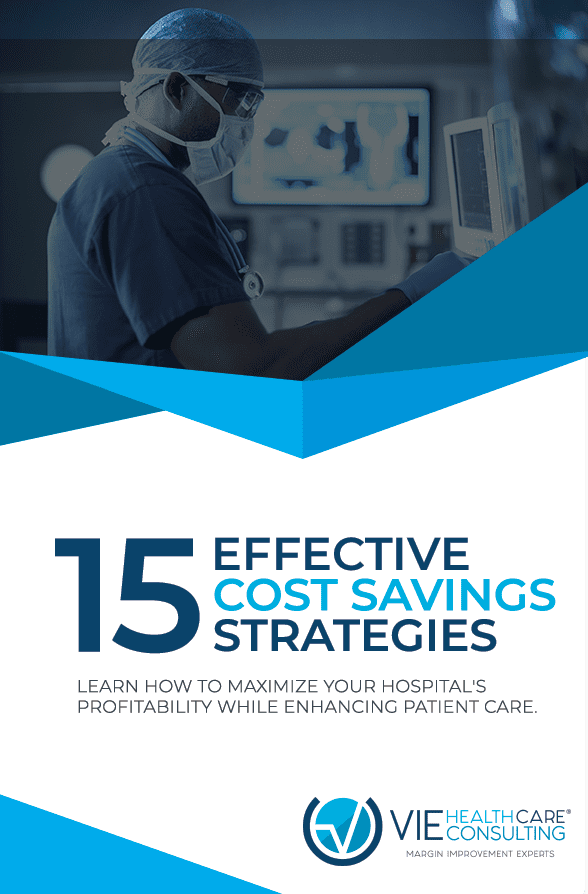Breaking Down Hospital Value-Based Purchasing
This article was written by James Cagliostro.
CMS has developed very specific measures in each of the following four domains to determine each hospital’s Total Performance Score (TPS). By gaining a fuller understanding of these measures, hospital administrator/staff will be more prepared to make decisions that will not only improve the quality of care they give but also increase the reimbursement they receive from CMS. Each domain accounts for 25% of CMS’s calculation for reimbursing hospitals, so it proves beneficial to consider each domain.
Clinical Care Domain
The Clinical Care Domain of CMS’s Hospital Value-Based Purchasing Program focuses on direct patient care and patient outcomes. More specifically, it measures the 30-day mortality rate of patients admitted for Acute Myocardial Infarction, Heart Failure, and Pneumonia. Mortality rates are estimates of deaths in the 30 days after admission to the hospital for the specific condition. According to Medicare.gov, “Death rates are measured within 30 days because deaths after a longer time period may have less to do with the care the hospital provided and more to do with other complicating illnesses, patients’ own behavior, or other care services patients received after they leave the hospital.” (https://www.medicare.gov/hospitalcompare/Data/Death-rates.html)
Measures that will be added in coming years include:
- Pneumonia (PN) 30-Day Mortality Rate (Updated Cohort) – FY 2021
- Total Hip Arthroplasty/Total Knee Arthroplasty Complication Rate – FY 2019
- Chronic Obstructive Pulmonary Disease (COPD) 30-Day Mortality Rate – FY 2021
- Coronary Artery Bypass Grafting (CABG) 30-Day Mortality Rate – FY 2022
These measures, which cover some of the most common reasons for admission to hospitals in this country, are selected based on “wide agreement” from CMS, the hospital industry, and public sector stakeholders like The Joint Commission (TJC), the National Quality Forum (NQF), and the Agency for Healthcare Research and Quality (AHRQ).
Patient- and Caregiver-Centered Experience of Care/Care Coordination Domain
The Patient- and Caregiver-Centered Experience of Care/Care Coordination Domain draws its data from the Hospital Consumer Assessment of Healthcare Providers and Systems (HCAHPS) Survey. The survey was developed by CMS and the AHRQ “to provide a standardized survey instrument and data collection methodology for measuring patients’ perspectives on hospital care.” (https://www.medicare.gov/hospitalcompare/Data/Overview.html)
The HCAHPS Survey is 32 questions in length—21 substantive items that cover various aspects of the hospital experience, 4 screening questions to skip patients to appropriate questions, and 7 demographic items that are used for adjusting the mix of patients across hospitals for analytical purposes. Measures are focused on:
- Communication with Nurses
- Communication with Doctors
- Responsiveness of Hospital Staff
- Communication about Medicines
- Hospital Cleanliness and Quietness
- Discharge Information
- 3-Item Care Transition (New for FY 2018)
- Overall Rating of Hospital
Data is gathered from surveys submitted throughout the year to calculate a star-rating for each hospital. To get HCAHPS star ratings, hospitals must have at least 100 completed HCAHPS surveys over a given four-quarter period. In addition, hospitals must be eligible for public reporting of HCAHPS measures. Hospitals with fewer than 100 completed HCAHPS surveys don’t get star ratings; however their HCAHPS measure scores are publicly reported on Hospital Compare. (https://www.medicare.gov/hospitalcompare/Data/HCAHPS-Star-Ratings.html)
Safety Domain
The Safety Domain measures events that affect patients’ overall well-being. A lower occurrence of these events means a higher level of quality care for the patient. For the Fiscal Year 2018 the events measured include:
- Catheter-Associated Urinary Tract Infection
- Central Line-Associated Blood Stream Infection
- Clostridium difficile Infection (C. difficile)
- Methicillin-Resistant Staphylococcus aureus Bacteremia
- Elective Delivery Prior to 39 Completed Weeks Gestation
- Surgical Site Infection for Colon surgeries and Abdominal Hysterectomy
- Pressure Ulcer Rate
- Latrogenic pneumothorax rate
- Central venous catheter-related bloodstream infection rate
- Postoperative hip fracture rate
- Perioperative pulmonary embolism or deep vein thrombosis rate
- Postoperative sepsis rate
- Postoperative wound dehiscence rate
- Accidental puncture or laceration rate
By monitoring the frequency of these Hospital Acquired Conditions (HACs), CMS hopes to motivate hospitals to do everything in their power to minimize the occurrence of these events. (https://www.medicare.gov/HospitalCompare/Data/safety-domain.html)
The Efficiency and Cost Reduction Domain
Through the Efficiency and Cost Reduction Domain, CMS measures the cost of care in an effort to increase the transparency of care for consumers by recognizing hospitals that provide high-quality care at lower costs to Medicare. The measure of efficiency is based on the Medicare Spending Per Beneficiary (MSPB), which is “an assessment of payment for services provided to a beneficiary during a spending-per-beneficiary episode that spans from 3 days prior to an inpatient hospital admission through 30 days after discharge.” Price Standardization and Risk Adjustments are performed to remove sources of variation. (https://www.medicare.gov/HospitalCompare/data/efficiency-cost-reduction-domain.html)
Using the MSPB Measure, CMS compares the hospital’s efficiency with the efficiency of the median hospital, specifically with regard to Medicare payments made during and MSPB episode.
Beginning in 2021, the 30-day Episode of Care for Acute Myocardial Infarction (AMI) and Heart Failure (HF) Payments will be considered in determining a hospital’s efficiency. Click To Tweet
The 30-day Episode-of-Care for Pneumonia (PN) Payment will be added in 2022.



